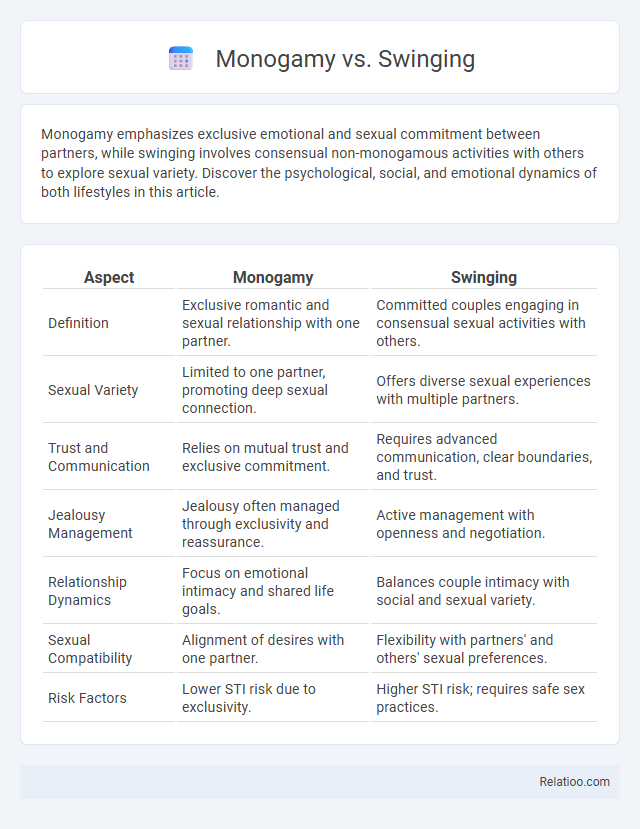Monogamy emphasizes exclusive emotional and sexual commitment between partners, while swinging involves consensual non-monogamous activities with others to explore sexual variety. Discover the psychological, social, and emotional dynamics of both lifestyles in this article.
Table of Comparison
| Aspect | Monogamy | Swinging |
|---|---|---|
| Definition | Exclusive romantic and sexual relationship with one partner. | Committed couples engaging in consensual sexual activities with others. |
| Sexual Variety | Limited to one partner, promoting deep sexual connection. | Offers diverse sexual experiences with multiple partners. |
| Trust and Communication | Relies on mutual trust and exclusive commitment. | Requires advanced communication, clear boundaries, and trust. |
| Jealousy Management | Jealousy often managed through exclusivity and reassurance. | Active management with openness and negotiation. |
| Relationship Dynamics | Focus on emotional intimacy and shared life goals. | Balances couple intimacy with social and sexual variety. |
| Sexual Compatibility | Alignment of desires with one partner. | Flexibility with partners' and others' sexual preferences. |
| Risk Factors | Lower STI risk due to exclusivity. | Higher STI risk; requires safe sex practices. |
Understanding Monogamy: Definition and Core Values
Monogamy is defined as a committed romantic relationship between two individuals who agree to exclusivity in emotional and physical intimacy, emphasizing trust, loyalty, and long-term partnership. Understanding your commitment within monogamy involves valuing open communication, mutual respect, and consistent emotional support to maintain relationship stability. These core values differentiate monogamy from swinging, where partners consensually engage with others, highlighting the importance of defining boundaries based on your relationship goals.
The Philosophy Behind Swinging
Swinging challenges traditional monogamous ideals by embracing consensual, non-exclusive sexual relationships aimed at enhancing intimacy and trust among partners. This philosophy prioritizes open communication, mutual consent, and emotional honesty, positioning sexual variety as a tool for strengthening relational bonds rather than undermining them. Embracing swinging requires a mindset shift from ownership to partnership, emphasizing freedom within commitment and challenging societal norms about fidelity.
Historical Perspectives on Relationships
Historical perspectives on relationships reveal monogamy as the dominant social norm in many cultures, emphasizing long-term pair bonding and social stability. Swinging emerged more prominently in the 20th century, particularly during the sexual revolution, challenging traditional monogamy by promoting consensual non-monogamous experiences. Your understanding of these relationship models is enriched by recognizing their cultural and temporal contexts, highlighting the evolving nature of human intimacy and social structures.
Emotional Intimacy: Monogamy vs Swinging
Emotional intimacy in monogamy often fosters deep trust and consistent connection between partners, building a stable foundation for long-term relationships. Swinging involves multiple partners, which can challenge emotional boundaries but may enhance communication skills and mutual understanding when managed with clear agreements. Navigating emotional intimacy in swinging requires heightened emotional awareness and negotiation to maintain trust and respect.
Communication and Trust in Both Lifestyles
Monogamy and swinging both rely heavily on clear communication and trust, but the dynamics differ significantly; monogamous relationships prioritize exclusivity, requiring partners to build deep emotional trust and consistently share feelings to maintain intimacy. Swinging demands even more explicit communication about boundaries, consent, and expectations to navigate multiple partners while preserving the primary relationship's trust. Your ability to openly discuss desires and establish mutual agreements is crucial in either lifestyle to foster understanding and avoid misunderstandings.
Common Myths and Misconceptions
Common myths about monogamy claim it is the only path to true intimacy, ignoring the fulfillment some find in consensual non-monogamous lifestyles like swinging. Swinging often faces misconceptions such as promoting promiscuity or lack of emotional connection, despite research showing trust and communication are foundational in these relationships. Monogamy, swinging, and polyamory each challenge societal norms differently, but all require commitment, honesty, and mutual respect to succeed.
Sexual Satisfaction and Variety
Sexual satisfaction often varies significantly between monogamy, swinging, and open relationships, with swinging providing greater variety through consensual partner exchanges, thereby enhancing novelty and excitement. Monogamy emphasizes emotional depth and consistent partner bonding, which can lead to heightened sexual satisfaction rooted in trust and exclusivity. Open relationships blend elements of both, offering increased sexual variety while maintaining emotional connections, potentially balancing satisfaction from novelty and intimacy.
Social Stigma and Cultural Acceptance
Monogamy enjoys widespread cultural acceptance and is often perceived as the social norm in many societies, whereas swinging faces significant social stigma due to its deviation from traditional relationship structures. Swinging communities challenge conventional views by promoting consensual non-monogamy, yet they remain marginalized and subject to judgment in both conservative and mainstream cultures. This disparity in cultural acceptance highlights the persistent influence of societal norms and moral frameworks on relationship models.
Navigating Jealousy and Boundaries
Navigating jealousy and boundaries in monogamy requires clear communication and mutual trust to maintain emotional security within your exclusive relationship. Swinging involves establishing explicit agreements and constant negotiation to manage jealousy while exploring connections with others, demanding heightened emotional awareness and respect for all parties' limits. Balancing these dynamics hinges on understanding personal triggers and consistently revisiting boundaries to ensure both partners feel valued and secure.
Choosing What Works: Personal Compatibility and Relationship Goals
Choosing between monogamy and swinging hinges on your personal compatibility and relationship goals, as each lifestyle demands distinct levels of trust, communication, and emotional boundaries. Monogamy emphasizes exclusive commitment, fostering deep emotional connection and long-term stability, while swinging introduces consensual non-monogamy, focusing on shared experiences and sexual exploration without compromising the primary bond. Evaluating your values, desires, and mutual expectations with your partner ensures a matching approach that nurtures satisfaction and relationship health.

Infographic: Monogamy vs Swinging
 relatioo.com
relatioo.com